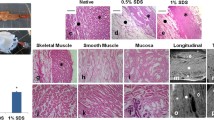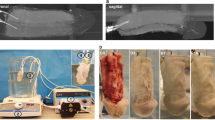Abstract
To evaluate the histological characteristics of decellularized human urethra after transplantation into the rat omentum and compare in vivo cell seeding with perfusion-based and cell sheet urethral regeneration. Eight adult human male urethras accompanied with the surrounding corpus spongiosum were obtained. The tissues were decellularized with detergent-based method. The efficacy of decellularization and extracellular matrix preservation was evaluated by several techniques. Decellularized scaffolds were transplanted into the omentum of 12 male rats and located into the scrotum. Biopsies were taken 1, 3, and 6 months postoperatively to assess the natural recellularization. Mesenchymal stem cells obtained from preputial tissue were seeded with perfusion-based and cell sheet techniques as well. Immunohistochemical staining with α-actin, cytokeratin AE1/AE3, synaptophysin, and CD31 antibodies were performed. Removal of nuclear components and preservation of biomechanical properties was confirmed. In-vivo recellularization revealed promising results in progressive angiogenesis and cell seeding of epithelium-like cells in the lining of the urethra as well as smooth muscle cells in the wall structure. In-vitro urethral regeneration revealed that cell sheet engineering was the technique of choice compared to perfusion-based technique. This study may paw the road for clinical application of acellular urethral matrix with the surrounding corpus spongiosum in urological reconstructive surgery.







Similar content being viewed by others
Abbreviations
- SEM:
-
Scanning electron microscopy
- ECM:
-
Extracellular matrix
References
Atala, A., et al. The potential role of tissue-engineered urethral substitution: clinical and preclinical studies. J. Tissue Eng. Regen. Med. 2015. doi:10.1002/term.2112.
Barbagli, G., et al. Bulbar urethroplasty using buccal mucosa grafts placed on the ventral, dorsal or lateral surface of the urethra: are results affected by the surgical technique? J. Urol. 174(3): 955–957, 2005; discussion 957–958.
Blaschko, S. D., et al. Repeat urethroplasty after failed urethral reconstruction: outcome analysis of 130 patients. J. Urol. 188(6):2260–2264, 2012.
Brown, B. N., and S. F. Badylak. Extracellular matrix as an inductive scaffold for functional tissue reconstruction. Transl. Res. 163(4):268–285, 2014.
Chen, F., J. J. Yoo, and A. Atala. Acellular collagen matrix as a possible “off the shelf” biomaterial for urethral repair. Urology 54(3):407–410, 1999.
Chen, F., J. J. Yoo, and A. Atala. Experimental and clinical experience using tissue regeneration for urethral reconstruction. World J. Urol. 18(1):67–70, 2000.
Chung, Y. G., et al. Acellular bi-layer silk fibroin scaffolds support tissue regeneration in a rabbit model of onlay urethroplasty. PLoS ONE 9(3):e91592, 2014.
De Filippo, R. E., et al. Penile urethra replacement with autologous cell-seeded tubularized collagen matrices. J. Tissue Eng. Regen. Med. 9(3):257–264, 2015.
Fu, Q., et al. Urethral replacement using epidermal cell-seeded tubular acellular bladder collagen matrix. BJU Int. 99(5):1162–1165, 2007.
Jia, W., et al. Urethral tissue regeneration using collagen scaffold modified with collagen binding VEGF in a beagle model. Biomaterials 69:45–55, 2015.
Kajbafzadeh, A. M., et al. The application of tissue-engineered preputial matrix and fibrin sealant for urethral reconstruction in rabbit model. Int. Urol. Nephrol. 46(8):1573–1580, 2014.
Korkes, F., et al. Recreational use of PDE5 inhibitors by young healthy men: recognizing this issue among medical students. J. Sex. Med. 5(10):2414–2418, 2008.
Kropp, B. P., et al. Rabbit urethral regeneration using small intestinal submucosa onlay grafts. Urology 52(1):138–142, 1998.
Laird, P. W., et al. Simplified mammalian DNA isolation procedure. Nucleic Acids Res. 19(15):4293, 1991.
le Roux, P. J. Endoscopic urethroplasty with unseeded small intestinal submucosa collagen matrix grafts: a pilot study. J. Urol. 173(1):140–143, 2005.
Li, C. L., et al. Urethral reconstruction using bone marrow mesenchymal stem cell- and smooth muscle cell-seeded bladder acellular matrix. Transplant. Proc. 45(9):3402–3407, 2013.
Matsuura, K., et al. Cell sheet approach for tissue engineering and regenerative medicine. J. Control. Release 190:228–239, 2014.
Najar, M., et al. Mesenchymal stromal cells from the foreskin: tissue isolation, cell characterization and immunobiological properties. Cytotherapy 18(3):320–335, 2016.
Orabi, H., et al. Cell-seeded tubularized scaffolds for reconstruction of long urethral defects: a preclinical study. Eur. Urol. 63(3):531–538, 2013.
Parnigotto, P. P., et al. Experimental defect in rabbit urethra repaired with acellular aortic matrix. Urol. Res. 28(1):46–51, 2000.
Peterson, A. C., and G. D. Webster. Management of urethral stricture disease: developing options for surgical intervention. BJU Int. 94(7):971–976, 2004.
Qi, N., W. J. Li, and H. Tian. A systematic review of animal and clinical studies on the use of scaffolds for urethral repair. J. Huazhong. Univ. Sci. Technol. Med. Sci. 36(1):111–117, 2016.
Raya-Rivera, A., et al. Tissue-engineered autologous urethras for patients who need reconstruction: an observational study. Lancet 377(9772):1175–1182, 2011.
Rehder, P., et al. Hypothesis that urethral bulb (corpus spongiosum) plays an active role in male urinary continence. Adv. Urol. 2016:6054730, 2016.
Ribeiro-Filho, L. A., and K. D. Sievert. Acellular matrix in urethral reconstruction. Adv. Drug Deliv. Rev. 82–83:38–46, 2015.
Sievert, K. D., and E. A. Tanagho. Organ-specific acellular matrix for reconstruction of the urinary tract. World J. Urol. 18(1):19–25, 2000.
Sinha, R. J., et al. Donor site morbidity in oral mucosa graft urethroplasty: implications of tobacco consumption. BMC Urol. 9:15, 2009.
Sivaraman, B., C. A. Bashur, and A. Ramamurthi. Advances in biomimetic regeneration of elastic matrix structures. Drug Deliv. Transl. Res. 2(5):323–350, 2012.
Tang, Z., and T. Okano. Recent development of temperature-responsive surfaces and their application for cell sheet engineering. Regen. Biomater. 1(1):91–102, 2014.
Xue, J. D., et al. Seeding cell approach for tissue-engineered urethral reconstruction in animal study: a systematic review and meta-analysis. Exp. Biol. Med. (Maywood) 241(13):1416–1428, 2016.
Acknowledgments
We are highly grateful from Mrs. S. Lotfi for her precise final linguistic revision of the manuscript.
Conflict of interest
No conflict of interest exists in relation to the submitted manuscript and there was no source of extra institutional commercial funding or funding received from National Institutes of Health (NIH), Wellcome Trust, Howard Hughes Medical Institute (HHMI) and others.
Author information
Authors and Affiliations
Corresponding author
Additional information
Associate Editor Christiani Amorim oversaw the review of this article.
Rights and permissions
About this article
Cite this article
Kajbafzadeh, AM., Abbasioun, R., Sabetkish, S. et al. Future Prospects for Human Tissue Engineered Urethra Transplantation: Decellularization and Recellularization-Based Urethra Regeneration. Ann Biomed Eng 45, 1795–1806 (2017). https://doi.org/10.1007/s10439-017-1857-x
Received:
Accepted:
Published:
Issue Date:
DOI: https://doi.org/10.1007/s10439-017-1857-x




